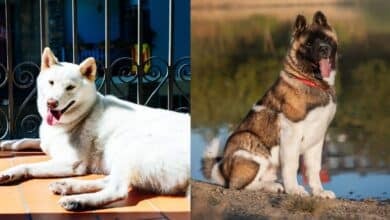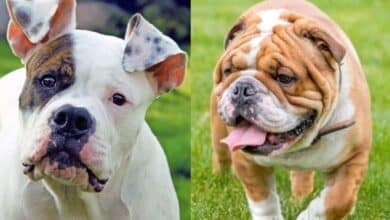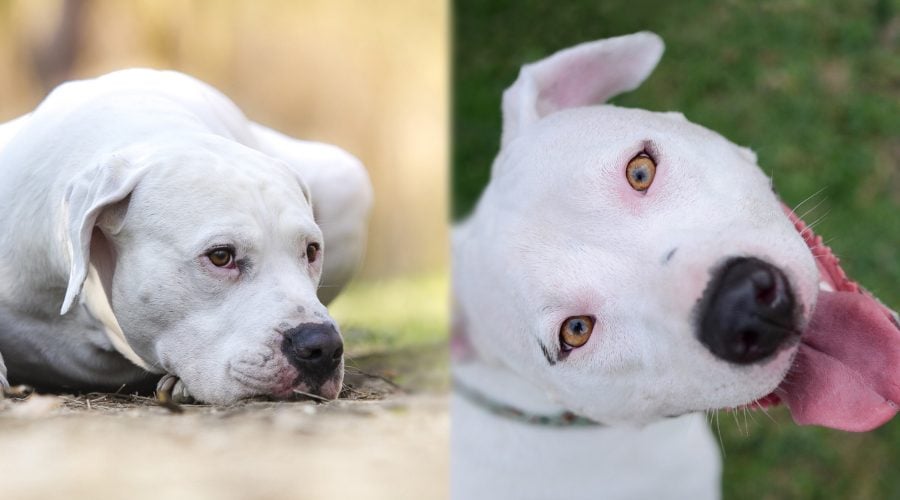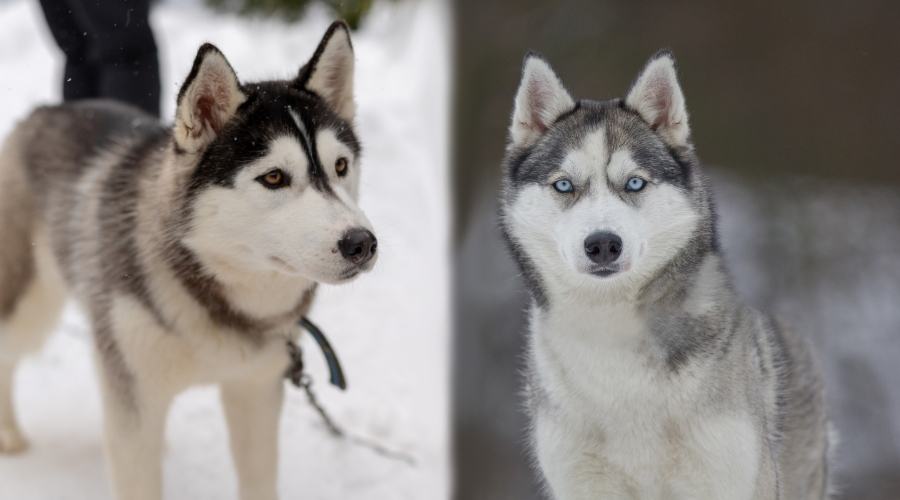Pug vs Boston Terrier: Breed Differences & Similarities
When you purchase through links on our site, we may earn a commission. Here’s how it works.
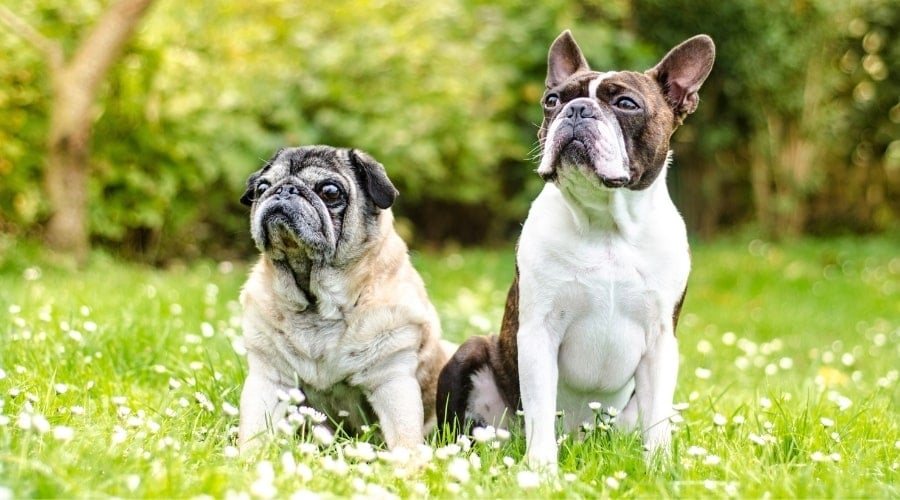
Are you considering either a Pug or a Boston Terrier as your next furry family addition? The two may have similar smushed, wrinkled faces, but they both are quite distinctly different breeds. While they are similar in many ways, they also have some distinct differences. Their bulging eyes and sweet, crinkled faces may just melt your heart. Before welcoming either one of these pint-sized pups into your home, you’ll want to understand the two breeds’ temperaments, health risks, exercise levels, and puppy prices before settling on the perfect pet.
Table of Contents
Breed Comparison
- Height10-14 Inches
- Height15-17 Inches
- Weight14-18 Pounds
- Weight12-25 Pounds
- TemperamentWarmhearted, Steadfast, Fun
- TemperamentLively, Stubborn, Intelligent
- EnergyLow Energy
- EnergyAverage
- HealthAverage
- HealthAverage
- Lifespan12-15 Years
- Lifespan13-15 Years
- Puppy Prices$1,000 and Up
- Puppy Prices$1,200 to $2,500
Key Differences
- The Pug is an older breed.
- Boston Terriers are larger, weighing 12 to 25 pounds.
- Pugs are smaller, weighing 14 to 18 pounds.
- Boston Terriers are more protective.
- Pugs are friendlier with older kids, while Boston Terriers can fit in with families of all ages.
- Boston Terriers are more active, smarter, and easier to train.
- Pugs are stubborn and harder to train.
- Boston Terriers have a slightly longer lifespan.
Breed History
To understand what a dog is like today, you need to know about its history. Both breeds have rich histories that have formed them into the dogs we know and love today. Because each pup was bred for different reasons, they have certain traits that they still possess today. To understand their background a bit better, let’s take a look at the origins of both breeds.
Pug
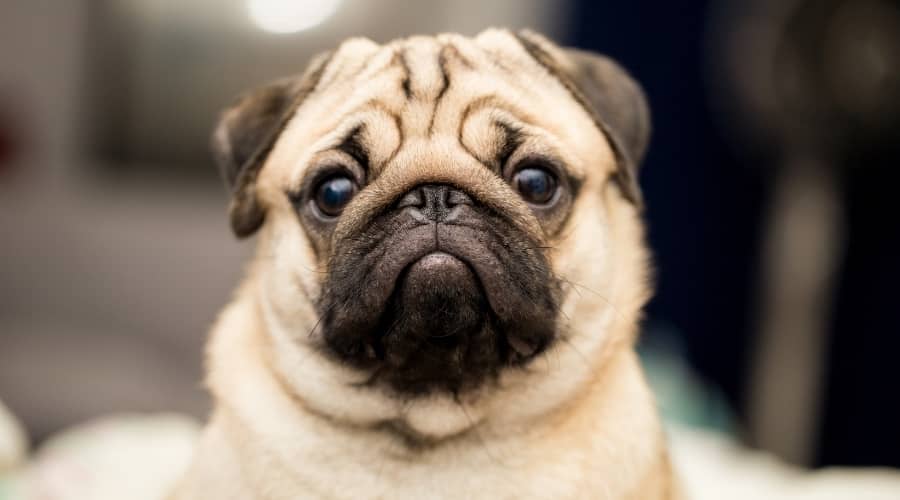
The Pug has a rich history dating back to the Han Dynasty in China, where they held royal status. It was not unlikely for Pugs to have servants and receive ranks during this time. However, back then, the breed was known as the Sichuan Pai dog. It wasn’t until the dog reached Western Europe that the name transformed into Pug.
Before reaching Western Europe, the breed spread throughout the Orient because of the widespread trade. The Dutch East India Trading Company, in particular, would bring Pugs back from the trade as precious cargo, leading to the breed’s increased popularity in the Netherlands.
From Holland, the breed traveled with William and Mary of Orange to assume the monarchy in England. Upon arrival in England among the royal court, the Pug ignited widespread fascination. Eventually, the Sichuan Pai dog dropped its name to become the dog we know and love today. They continue to be popular as pets and as Pug crossbreeds.
Boston Terrier
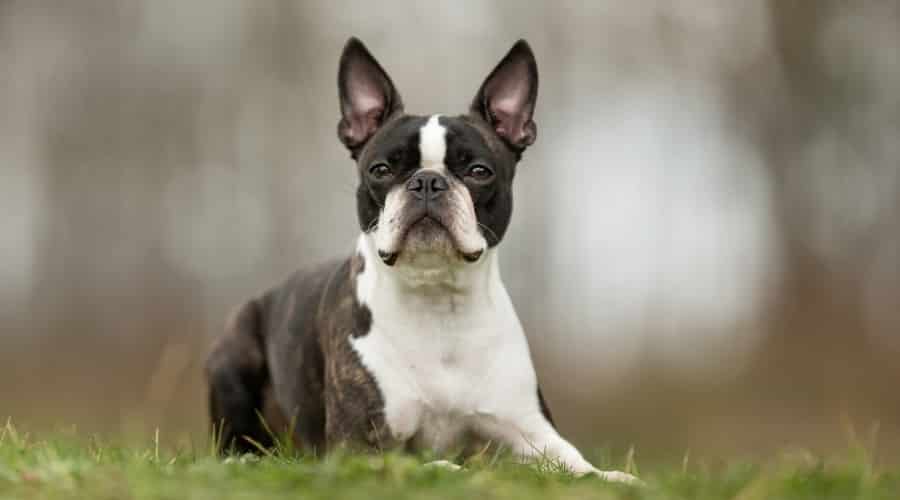
Boston Terriers were developed in the United States specifically for dog fighting. Today, dog fighting is outlawed and frowned upon, but that wasn’t the case in 19th-century England. Dog fighting, or blood sport, drew large crowds, spread in popularity, and incited mania for crossbreeding terriers and bull-breeds in hopes of creating the ultimate fighting dog. Unfortunately, the crossbreeding for dogfighting in England led to the creation of the breed.
The original dog was a cross between a typical Bulldog and the white English terrier, which is now extinct. The result? A muscular, compact dog named Judge. Eventually, a man named William O’Brien purchased Judge and brought him home to Boston in the United States. Once in Boston, a man named Robert C. Hooper purchased Judge.
With Hooper, Judge became formally known as “Hooper’s Judge” and became the breed’s bloodline patriarch as the prominent ancestor. With Judge’s passed-down genetics, his poise, disposition, and prestigious-looking black and white coat came about; thus, the breed earned the nickname “the American Gentleman.”
Throughout the early 1900s, the breed ranked among the most popular household dogs in the United States. While not as popular today, it remains a popular breed.
Appearance
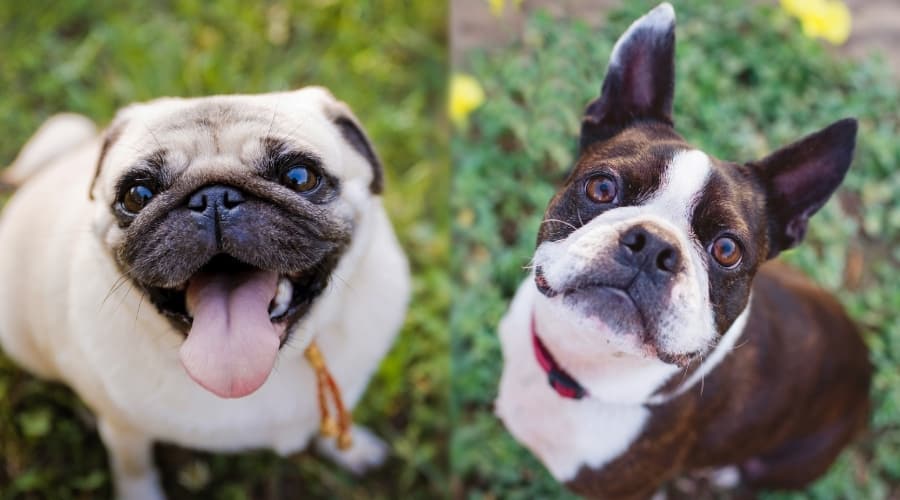
Small in stature, compact, bulging bug eyes, and wrinkle-clad faces, both breeds share quite a few similar appearance characteristics. Based on facial features, the two breeds appear related. When you look more closely at the animals wholly, you’ll see that they differ significantly.
One of the main differences between both dog breeds is their size. Bostons stand taller at around 15 to 17 inches because of their long legs, while smaller breeds. The Pug, on the other hand, stands a few inches shorter at around 10 to 13 inches.
While Pugs appear a bit chubby because of their rolls and height, Bostons weigh, on average, more. They can weigh anywhere from 12 to 25 pounds, while the Pug weighs between 14 and 18 pounds.
The breeds’ coats also differ in appearance. The Pug can come in either black or tan and, in some rare occurrences, can be white. Boston Terriers come in various colors, all of which contain a white-based coloring. They can also have a brindle-colored coat. The most popular and apparent shade for Bostons is the well-known black and white tuxedo look.
Another more minute detail is the breeds’ tails. The Pug has a short, curled pig-like tail, but Bostons have a clipped, very short, nubby tail.
Temperament
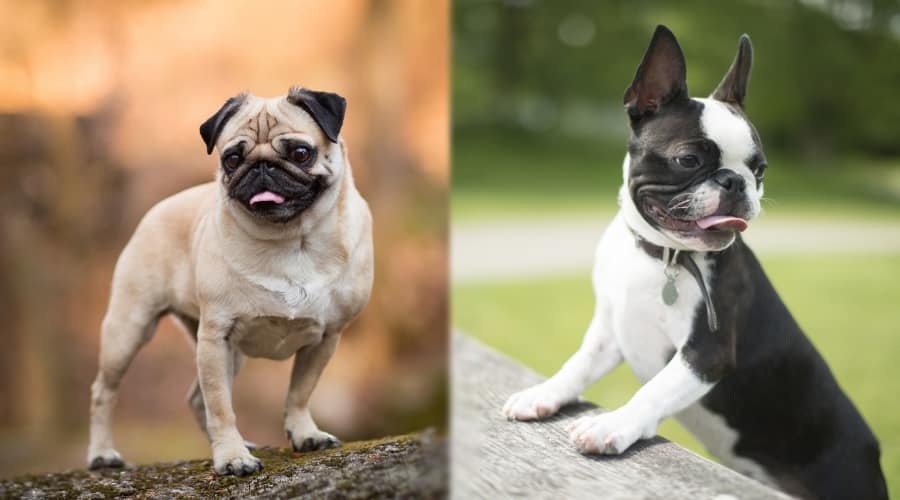
People consider dogs man’s best friend because they are friendly and loving animals that make great companions. Both of these family-friendly canines are no exception. They both ooze friendliness and love company.
The Pug finds comfort no matter where they live and often enjoys lounging around the house, fun playtimes, and hanging around other people and dogs. They also do well in multi-pet households if raised in them from a young age and socialized early. Pugs like kids but do better in homes with older children due to their smaller size.
Similarly, Bostons adapt to their living situation, whether that’s a tight apartment or a vast, open ranch. They have a bit more energy than the two different breeds. While they can lounge around with you all day, they also enjoy getting out and about for playtime. They are also quite amusing because of their playful nature. Their entertaining character makes it a funny little friend to have around.
Boston Terriers vocalize a bit more of the two breeds. While not consistently yappy, they are known to bark more frequently, which can be annoying for those living in tighter living quarters or apartments.
Exercise
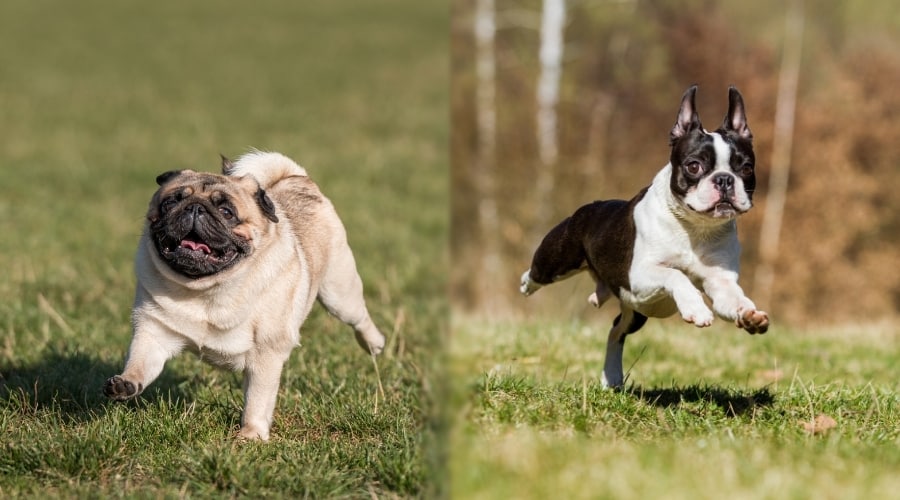
No dog is content sleeping around all day, every day, but the Pug comes close. The Pug’s agreeable and eager-to-please nature makes it the ideal snuggle buddy for days when you want nothing more than to binge-watch movies all day.
As much as you may want to, keeping your Pug inside all day with nothing to do but sleep isn’t great for its physical and mental health. Pugs still require a substantial amount of playtime during the day to keep them active, fit, and happy. You won’t have to jog them around the block or throw the ball for them endlessly, but engage in some light playtime throughout the day.
Both dog breeds don’t require an extensive amount of exercise, especially since they no longer participate in dog fights like their ancestors. They do need some exercise, though, some more than others. Both dogs behave better if taken for brisk walks at least once or twice during the day.
Letting your Boston Terrier out into the yard to run on its own won’t do the trick either. If you let them outside to blow off steam, go with them; otherwise, they’ll wait for you to come out or let them inside. Ignoring their activity needs only results in resentment or destructive behavior, and the last thing you want or need is your dog to tear up your furniture.
Training
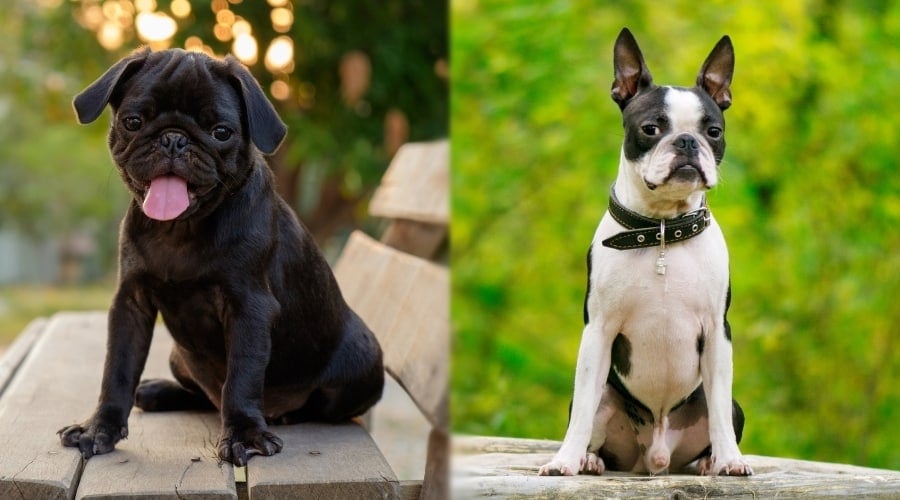
Boston Terriers were bred for sport and are eager to please and enjoy a bit of competition. Because of this, they take to training with relative ease, especially regarding speed or agility skills.
Both dog breeds are rather sensitive. The Breeds can sense harsh or crude language, and rather than stand their ground or succumb to stubbornness, they grow sad and reluctant. Pugs are also known to be less intelligent than other breeds. For both pups, you’d do well to reinforce their training either with treats or positive praise.
During training, Bostons also benefit from the warmth and gentle corrections. If they mess up a skill or don’t fully grasp a training concept, gently nudge them in the right direction with kind words and positivity. A little kindness goes a long way in training.
Both breeds need training sessions early on for socialization. You want your dog to develop into a well-mannered, friendly dog, and socialization can achieve this.
Ease your dog in to social settings, whether with other dogs, other people, or both. Don’t rush them into it. As they get the hang of the training, you can increase their exposure frequency until they’re entirely comfortable with people, dogs, and strangers alike.
Health
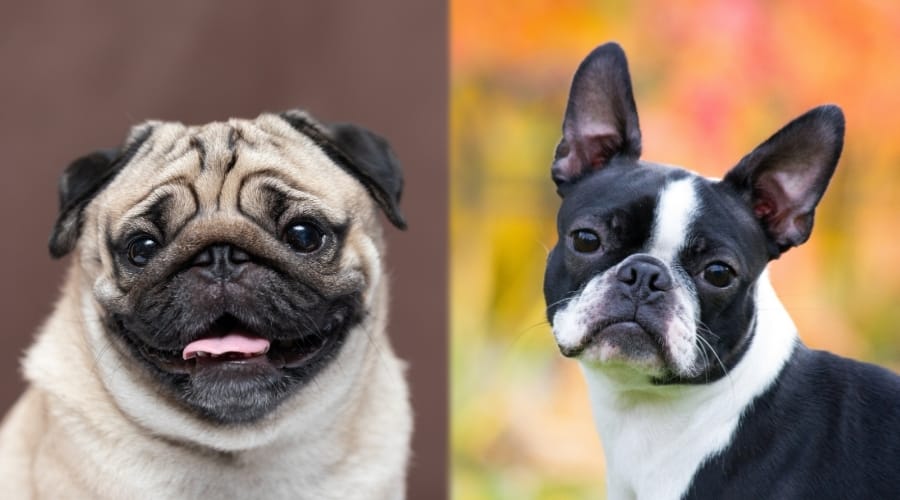
I often see the question, “Are Boston Terriers healthier than Pugs?” The answer is no. Both Pugs and Boston Terriers are both brachycephalic breeds and, as such, are prone to some health problems.
Brachycephalic airway syndrome, in particular, is a big risk. While both dog breeds charm their owners and spectators with their large, glossy eyes, their eyes can attract serious health conditions such as cataracts, Cherry Eye, corneal ulcers, and dry eye. Because of these potential risks, you need to monitor and check up on their eyes frequently.
Pugs, because of their love of food, have the potential to become obese. When considering their food, you should monitor your Pug’s caloric intake, weight, and activity levels to maintain a healthy lifestyle.
Bostons, however, are prone to a few more health risks, specifically deafness. They have large, pointy ears similar to those of French Bulldogs. Due to their size and proportion, they have an increased likelihood of becoming deaf in one or both ears during their lifetime.
Pet insurance is worth considering for these two brachycephalic breeds because of their risk of these and other health problems. Pet insurance will not cover pre-existing conditions or routine care, but it can be beneficial in the case of an expensive emergency, injury, or long-term illness. In some cases, it can help you access lifesaving care for your pet that you would not otherwise be able to afford. You can learn more about pet insurance, how it works, and our top recommendations in our best pet insurance guide.
Nutrition
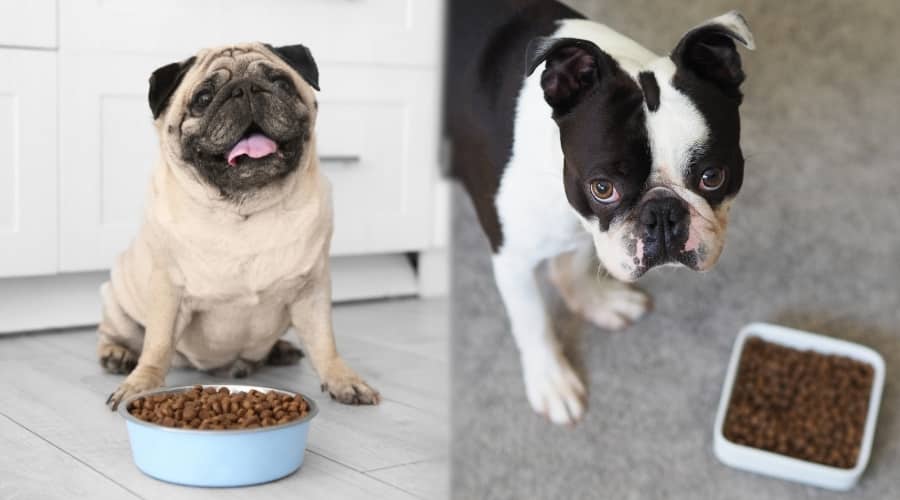
All dog breeds require a balanced diet to maintain and achieve optimal health; therefore, a balanced diet is necessary for both breeds. They need the appropriate levels of minerals, vitamins, fats, proteins, and carbohydrates, depending on their size.
Since Pugs love to eat and have an increased likelihood of obesity, you need to watch out for your Pug’s caloric intake, including the level of fat in their diet and the number of treats they get in a day. Monitoring their weight and activity level helps inform you of how much food they require. Making sure they are eating a dog food formula made for Pugs and their nutritional needs is essential.
While Boston Terriers are the less likely of the two to become obese, becoming overweight is still probable. Since you don’t want your dog to become overweight and unhealthy, you should monitor its food intake as well. Since Bostons require a bit more activity, look for a more calorie-dense dog food formulated for Boston Terriers.
Grooming
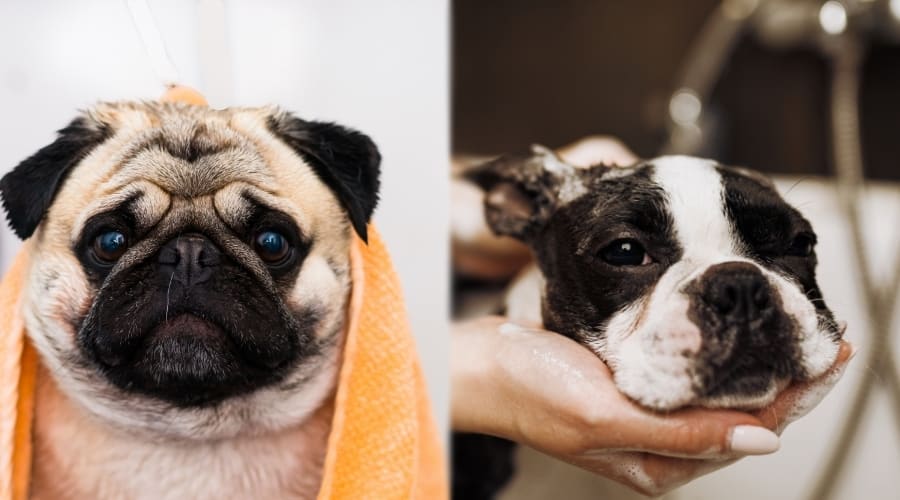
The level and frequency of grooming depend on your dog’s fur. If the dog’s coat is thicker or longer, then it requires more attention. The Pug, for instance, sheds often. As a result, the Pug requires weekly brushing and would benefit from special shedding tools such as a grooming mitt.
However, just because Pugs need frequent brushing doesn’t mean they need regular baths. They rarely need to be given baths. Only bathe your Pug as you see fit, whether it messed up its coat rolling around in something outside or looks a little too weathered.
Boston Terriers require very little maintenance, even less so than the Pug. Its short coat rarely sheds, so you won’t have to worry about tedious brushing routines. The terrier’s coat length also means that it won’t require baths too often, but rather only as you see fit, similar to a Pug’s bathing needs.
Puppy Prices
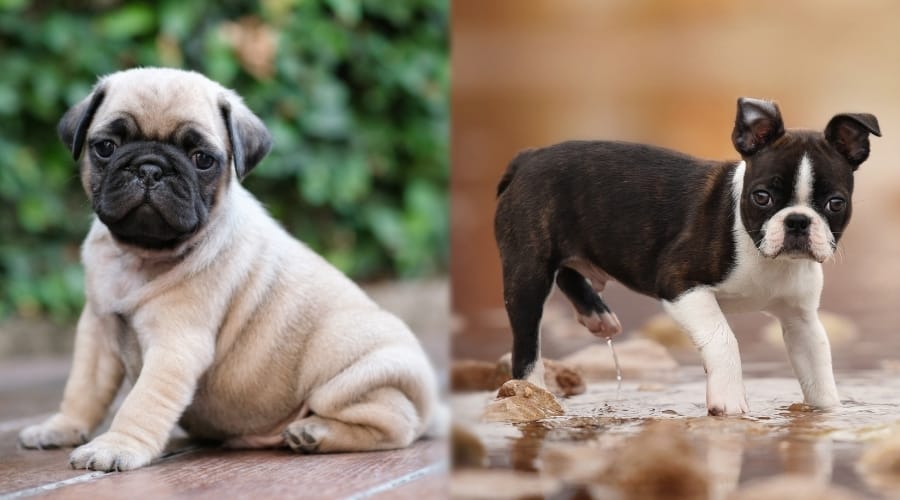
The price of any dog, no matter the breed, really depends on where you live, where or who you buy from, and the breed’s popularity at the time of purchase. Typically, purebred puppies of both breeds cost about the same amount with a similar price range of anywhere between $1,000 and $2,500.
With both dog breeds, you can expect to pay more if you are buying from a breeder that has championship lines. This is more common for people who plan to show their dogs. You may also pay a little more if your pup has a unique color combination that other dogs don’t have.
Caring For Small Dogs
Small dogs are amazing companions, especially for small homes and apartments. However, there are a few things to know about caring for pint-sized pups. You must start training early, as they often get away with a lot of naughty behavior due to being so small and cute. You also must be very firm with potty training as they often sneak off to a corner rather than going outside. Many smaller breeds suffer from separation anxiety, so be sure that someone is home with them or that you can come and check on them every few hours.
Why Trust Canine Journal?
Michelle has been a dog owner her entire life and is one of the founders of this website. While she has never owned these two breeds, she has spent lots of time with friends’ lovable Bostons and Pugs, making her especially fond of these two short-nosed breeds. Michelle is also a licensed insurance agent who specializes in pet insurance. She’s part of a team of dog specialists at Canine Journal who have over a decade of experience researching, testing, and writing about everything you need to know to keep your pup healthy and happy.
